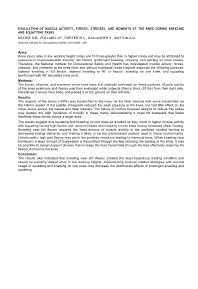Mining Publication: Evaluation of Muscle Activity, Forces, Stresses, and Moments at the Knee During Kneeling and Squatting Tasks
Original creation date: August 2010
Knee injury rates in low working height mines are 10 times greater than in higher mines and may be attributed to exposure to musculoskeletal disorder risk factors (prolonged kneeling, crawling, and twisting on ones knees). Therefore, the National Institute for Occupational Safety and Health has investigated muscle activity, forces, stresses, and moments at the knee (with and without kneepads) while subjects assumed the following postures: bilateral kneeling in full flexion, bilateral kneeling at 90° of flexion, kneeling on one knee, and squatting (performed with 48” simulated mine roof). The forces, stresses, and moments at the knee were first statically evaluated for these postures. Muscle activity of the knee extensors and flexors was then evaluated while subjects lifted a block (25 lbs) from their right side, transferred it across their body, and placed it on the ground on their left side. The majority of the stress (>60%) was transmitted to the knee via the tibial tubercle with some transmitted via the inferior aspect of the patella. Kneepads reduced the peak pressure at the knee, but had little effect on the mean stress across the patella and tibial tubercle. The failure of current kneepad designs to reduce this stress may explain the high incidence of bursitis in these mines demonstrating a need for kneepads that better distribute these forces across a larger area. The results suggest that squatting and kneeling on one knee be avoided as they result in higher muscle activity with squatting having high flexion and varus moments and kneeling on one knee having increased shear loading. Kneeling near full flexion required the least amount of muscle activity of the postures studied lending to decreased energy demands and making it likely to be the predominant posture used in these environments. Unfortunately, high joint flexion may pinch the posterior meniscus leading to meniscal tears. When kneeling near full flexion, a large amount of bodyweight is transmitted through the feet reducing the loading at the knee. It may be possible to design support devices that increase the load transmitted through the feet effectively reducing the flexion moment at the knee. The results also indicated that kneeling near 90° of flexion created the least hazardous loading condition and should be primarily utilized when in low working heights. Implementing postural rotation strategies with minimal usage of squatting and kneeling on one knee may decrease the detrimental effects of prolonged kneeling and squatting.
Authors: SM Moore, JP Pollard, WL Porter, S Gallagher, AG Mayton
Conference Paper - August 2010
NIOSHTIC2 Number: 20038058
Seventh International Scientific Conference on Prevention of Work-Related Musculoskeletal Disorders (PREMUS 2010), August 29 - September 2, 2010 Angers, France. Rome, Italy: International Commission on Occupational Health (ICOH), 2010 Aug-Sep; :192
See Also
- Demands on the Knee During Kneeling and Squatting Activities Common to Low-seam Mining
- Development and Evaluation of Prototype Kneepads for the Low-Seam Mining Industry
- Electromyography of the Thigh Muscles during Lifting Tasks in Kneeling and Squatting Postures
- Forces and Moments on the Knee During Kneeling and Squatting
- Keeping Knees Healthy in Restricted Work Spaces: Applications in Low-Seam Mining
- Pressure Distribution on the Anatomic Landmarks of the Knee and the Effect of Kneepads
- Pressures Applied to Anatomical Landmarks of the Knee While in Kneeling Postures
- Task-Specific Postures in Low-Seam Underground Coal Mining
- Thigh-Calf and Heel-Gluteus Contact Forces in High Flexion: Experimental Results
- Working in Unusual or Restricted Postures
- Page last reviewed: 11/19/2015
- Page last updated: 11/19/2015
- Content source: National Institute for Occupational Safety and Health, Mining Program


 ShareCompartir
ShareCompartir
